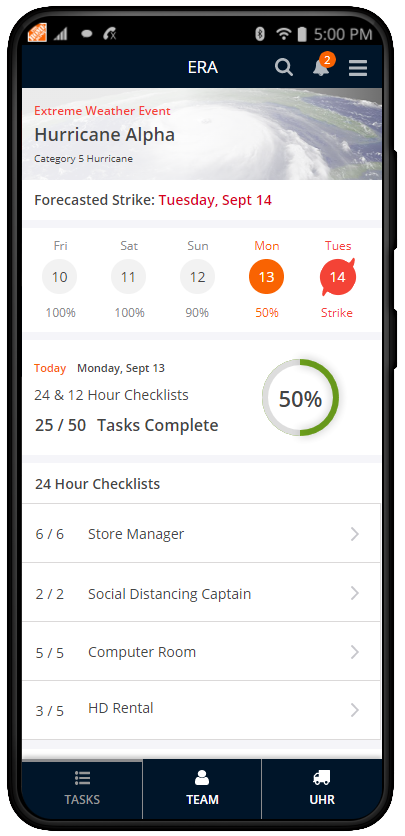

Overview
The Home Depot is the largest home improvement retailer in the United States, with nearly 500,000 employees and annual revenues exceeding $100 billion. They are often the first name that comes to mind when it’s time to repair one’s home. This couldn’t be more true during a natural disaster event.
Until recently, The Home Depot’s operation during natural disasters consisted of many antiquated processes. Printed checklists, manual reports, email chains, and numerous phone calls. They made this work over the years but not without considerable pain points. Lost revenue, slowed responses, miscommunication, and chaotic situations. With so much of the company’s regular operation having been digitally transformed over the years, it seemed time to transform its emergency operation as well.
Emergency Response Application
The Emergency Response Application (ERA) would serve The Home Depot’s natural disaster response with three key components. Digitized emergency checklists, a human resource hub, and emergency freight tracking. Digitizing the checklists would greatly reduce the amount of manual reporting between, store managers, district managers, regional managers, and the command center. The human resource hub would reduce the time needed to assess the safety and availability of employees. The emergency freight tracking would provide more visibility on items en route to a disaster-struck location.
Digitized Emergency Checklists
Problem
The Home Depot’s instructional checklists for pre and post-strike tasks only existed in print format. The lists would be printed by store managers and progress would be reported through ad-hoc emails, texts, and phone calls. This process resulted in slow communication, redundant updates, and problems with collaboration overall. 
“Some type of training needs to be in place, especially for new store managers.”
Store Manager: Lake Charles, LA
“Communication is on the fly. Sometimes it’s texting, sometimes it’s email, and there are a lot of phone calls.”
Store Manager: Tampa, FL
Solution
By digitizing the emergency checklists, we can streamline communication and status reports so managers and associates can stay focused on the tasks at hand. Additionally, we can provide instructional media to promote best practices while responding to a disaster event.




Human Resource Hub
Problem
Many associates do not report to work leading up to and especially following a storm disaster. Determining the safety and availability of associates requires multiple phone calls and text messages. Store Managers often have to reopen their store in a limited capacity with few associates. 
“You don’t really have a way to know who’s gonna show up.” Store Manager: Tampa, FL
“You plan a recovery team, but nobody could have told me that my whole team would be trapped at home.” Store Manager: La Place, LA
Solution
By creating a centralized platform for managers and human resources to track the safety and availability of associates we can reduce the amount of time required to determine the need for volunteers and emergency resources.




Emergency Freight Tracking
Problem
There is little visibility on the status of incoming freight and support. Once orders are put en route, it is difficult to determine their estimated time of arrival. 
“A lot of time was wasted just rearranging the extraordinary amount of freight to get things out.”
Store Manager: La Place, LA
“I’m trying to figure out what’s the timing, what’s the action on this stuff.”
Store Manager: Tampa, FL
Solution
With an application that provides the status of incoming freight and emergency supplies, stores can assess the resources required to effectively receive the freight. Furthermore, it would enable stores to provide more assurance to customers in need of emergency supplies.



In the News

